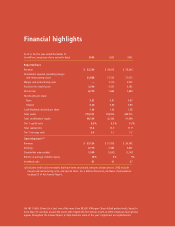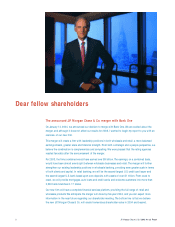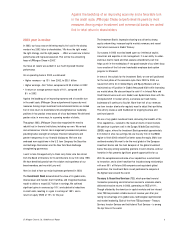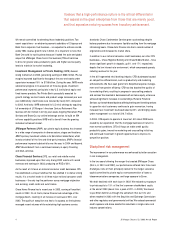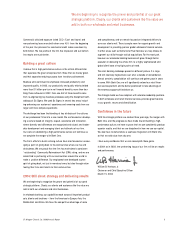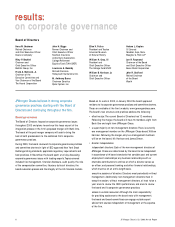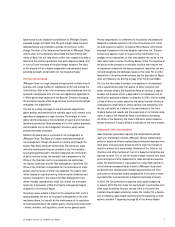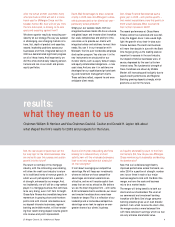JP Morgan Chase 2003 Annual Report Download - page 9
Download and view the complete annual report
Please find page 9 of the 2003 JP Morgan Chase annual report below. You can navigate through the pages in the report by either clicking on the pages listed below, or by using the keyword search tool below to find specific information within the annual report.
J.P. Morgan Chase & Co. / 2003 Annual Report 7
Primary responsibility for adherence to the policies and procedures
designed to address reputation risk lies with business units, which
are also required to submit, to regional Policy Review Committees,
proposed transactions that may heighten reputation risk. The com-
mittees may approve, reject or require further clarification of or
changes to the transactions, or they may escalate the review to the
most senior level of review, the Policy Review Office. The objective of
the policy review process is to reinforce a culture that ensures that
all employees understand the basic principles of reputation risk con-
trol and recognizes and addresses issues as they arise. For a further
description of the policy review process, see the discussion of Reput-
ation and Fiduciary risk starting at page 73 of this Annual Report.
The firm has two codes of conduct, one applying to all employees
and a supplementary code that applies to senior executive and
senior financial officers. The Worldwide Rules of Conduct, a code of
conduct and business ethics, is applicable to all employees and, as
modified by applicable addenda, to directors. In 2003, the firm added
a Code of Ethics for senior executive and senior financial officers to
underscore the importance of ethical conduct and compliance with
the law, particularly as it relates to the maintenance of the firm’s
financial books and records and the preparation of its financial state-
ments. A copy of the Worldwide Rules is available by contacting
the Office of the Secretary. The Code of Ethics for senior executive
officers and senior financial officers is available at the firm’s website.
Alignment with shareholders
Good corporate governance requires that compensation policies
align with shareholder interests. JPMorgan Chase’s compensation
policy for executive officers emphasizes performance-based pay over
fixed salary and uses equity-based awards to align the interests of
executive officers with shareholders. Members of the Office of the
Chairman and other members of the firm’s Executive Committee are
required to retain 75% of the net shares of stock received from stock
grants and options (after deductions for taxes and options exercise
costs). The board believes it is desirable that a significant portion of
overall director compensation be linked to JPMorgan Chase stock;
the board’s total compensation includes approximately one-third
cash and two-thirds stock-based compensation in the form of share
equivalents that must be held until a director’s termination of service.
In 2002, the firm committed to expense stock options beginning
in January 2003. The firm made this commitment in partnership with
other large, diversified financial services firms, in the belief that
investors should expect consistency across the industry. For a descrip-
tion of employee stock-based incentives and the expensing of stock
options, see Note 7 beginning on page 93 of this Annual Report.
Governance was an important consideration in JPMorgan Chase’s
proposed merger with Bank One. The post-merger board structure
described above was intended to provide for continuity within
change. The chair of the Governance Committee of JPMorgan Chase
and the chair of the Corporate Governance and Nominating Com-
mittee of Bank One will lead efforts within their respective boards to
determine the continuing directors from each respective board, who
in turn will form the board of the post-merger company. The result
of this process will be a highly independent and competent board
providing oversight and direction for the merged company.
Internal governance
JPM organ Chase is a large, complex enterprise with multiple lines of
business and a large number of subsidiaries within and outside the
United States. Each of the firm’s businesses and subsidiaries must be
operated in compliance with the laws and regulations applicable to
it. While governance begins with the Board of Directors, managing
the enterprise requires effective governance structures and practices
throughout the organization.
The firm as a whole manages by line of business, supported by
global policies and standards that typically apply to all relevant units
regardless of geography or legal structure. The strength of these
global control processes is the foundation of regional and individual
subsidiary governance. Three examples of the firm’s global processes
and standards are its risk management structure, policy review
process and codes of conduct.
Defined risk governance is a principle of risk management at
JPM organ Chase. The Board of Directors exercises oversight of
risk management through the board as a whole and through the
board’s Risk Policy and Audit Committees. The charters of these
and other board committees are available at the firm’s website
(www.jpmorganchase.com). The board delegates the formulation
of policy and day-to-day risk oversight and management to the
Office of the Chairman and to two corporate risk committees,
the Capital Committee and the Risk Management Committee. The
Office of the Chairman is responsible for the formulation of major
policies and the review of major risk exposures. The Capital Com-
mittee focuses on capital planning, internal capital allocation and
liquidity management. The focus of the Risk Management Com-
mittee includes, among others, credit risk, market risk and opera-
tional risk. A discussion of Risk and Capital management begins
at page 45 of this Annual Report.
The policy review process is based on the recognition that a firm’s
success depends not only on its prudent management of the risks
mentioned above, but equally on the maintenance of its reputation
for business practices of the highest quality, among many constituents
–clients, investors, and regulators, as well as the general public.


